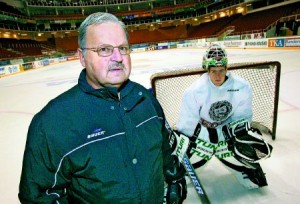02.25.14A Coaching Outlier: We’re not training kids to be their best when they’re 13
 Great article by Chris Koentges last week in the Atlantic on the topic of how Finland became a hot spot—in the Daniel Coyle sense—for developing goalies.
Great article by Chris Koentges last week in the Atlantic on the topic of how Finland became a hot spot—in the Daniel Coyle sense—for developing goalies.
Here’s a link and six takeaways I had on the coaching front from reading the article. My observations are soccer-centric, but not hard to apply elsewhere I am sure. Love to hear your takeaways too.
http://www.theatlantic.com/features/archive/2014/03/the-puck-stops-here/357579/
1) Ylonen’s description of what he does–“We’re not training kids to be their best when they’re 13. I’m looking at what you need to do as a 13-year old so you can reach your full potential”—is pretty much the definition of what coaching should be. That it leads to outlier results ALSO is gravy.
2) The master coach—Ylonen—is calm and composed in teaching so the player can be calm and composed in executing. I tried to hit that point in a recent article in SoccerAmerica. When you bring your emotions into it you add one more variable that distracts the player from thinking about his or her own execution.
3) Being a goalie is all about data. The numbers are in managing second-chances more than blocking the first shot, even though the big block is more dramatic and heroic (and thus we are inclined to teach the latter.) We are still beholden to all kinds of prejudices in what we teach, some we don’t know about yet because we haven’t discovered them but some we are beholden to even though we DO know. See further: “Failing to teach goalies and defenders to build out of the back.”
4) The signature move of many goalies is the “butterfly” because it’s so useful. And because it’s so useful the tendency of coaches is to teach kids to over-rely on it.
5) Being a goalie, it turns out, is more about skating than most people know. Skating is a “quiet skill” and like so many of the key drivers of performance is often hidden because of its foundational nature.
6) “’I never had a goalie coach’….They were all self-taught.” This quote from a goalie, and observation about goalies, seems to apply to an immense percentage of US goalkeepers. And maybe even central defenders. (and teachers and coaches incidentally) One US Soccer coach I really admire said “The over-whelming majority of coaches spend the overwhelming majority of time on the offensive side of the ball.” The result is that those on the defensive side of the ball are often under-coached or self- taught. There’s a sort of tyranny of the majority. The majority of players and the majority of are on attacking with the ball so those with minority pursuits- ie positions like goalkeeper or central defender—are often left to intuit the solutions.
